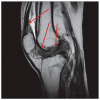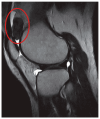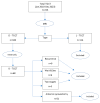Diffuse-Type Tenosynovial Giant Cell Tumor of the Knee: Clinical Course After Anterior Open Synovectomy
- PMID: 40558285
- PMCID: PMC12191732
- DOI: 10.3390/curroncol32060342
Diffuse-Type Tenosynovial Giant Cell Tumor of the Knee: Clinical Course After Anterior Open Synovectomy
Abstract
Diffuse type tenosynovial giant cell tumor (D-TGCT) of the knee presents with stiffness, pain and swelling with surgery being the mainstay treatment. However, the literature lacks data on clinical course of range of motion, pain (ROM), and swelling after open synovectomy for D-TGCT. Therefore, this study aims to evaluate clinical course after open anterior synovectomy. A retrospective analysis was conducted on 214 patients treated for TGCT at our Institutions between 2010 and 2023. 51 patients with anterior knee D-TGCT who underwent open anterior synovectomy were included. Pre- and postoperative assessments included ROM, pain (VAS scale), and reported swelling. The mean knee flexion increased from 100° (SD 14.28) preoperatively to 131.8° (12.64) at 12 months post-surgery. Knee extension remained stable, ranging from 178.4° preoperatively to 179.2° at the final follow-up. Pain decreased from a mean of 5.0 (SD 2.8) preoperatively to 0.5 (SD 0.7) at 12 months. Swelling was initially reported in 90.4% of patients, with 95.74% of them showing improvement at six months, and 100% at 12 months. Open anterior synovectomy effectively improves knee function, pain, swelling in patients with anterior knee D-TGCT, although functional recovery may take up to 6-12 months.
Keywords: pain; pigmented villonodular synovitis; range of motion; swelling; tenosynovial giant cell tumor.
Conflict of interest statement
The Authors declare no conflicts of interest.
Figures






Similar articles
-
Satisfactory functional outcomes and low recurrence rates at a mean 10-year follow-up after combined staged synovectomy and external radiotherapy for diffuse pigmented villonodular synovitis of the knee.J ISAKOS. 2025 Aug;13:100907. doi: 10.1016/j.jisako.2025.100907. Epub 2025 May 24. J ISAKOS. 2025. PMID: 40419142
-
Giant cell tumor of tendon sheath: Open surgery or arthroscopic synovectomy? A systematic review of the literature.Orthop Traumatol Surg Res. 2017 Sep;103(5):809-814. doi: 10.1016/j.otsr.2017.03.016. Epub 2017 Apr 17. Orthop Traumatol Surg Res. 2017. PMID: 28428036
-
Cryotherapy following total knee replacement.Cochrane Database Syst Rev. 2023 Sep 14;9(9):CD007911. doi: 10.1002/14651858.CD007911.pub3. Cochrane Database Syst Rev. 2023. PMID: 37706609 Free PMC article.
-
Management of tenosynovial giant cell tumour of the temporomandibular joint: a systematic review.ANZ J Surg. 2023 Apr;93(4):869-875. doi: 10.1111/ans.18186. Epub 2022 Dec 14. ANZ J Surg. 2023. PMID: 37052058
-
Extensile Anterior and Posterior Knee Exposure for Complete Synovectomy of Diffuse Tenosynovial Giant Cell Tumor (Pigmented Villonodular Synovitis).JBJS Essent Surg Tech. 2022 May 25;12(2):e21.00035. doi: 10.2106/JBJS.ST.21.00035. eCollection 2022 Apr-Jun. JBJS Essent Surg Tech. 2022. PMID: 36741035 Free PMC article.
References
-
- Fletcher C.D., Bridge J.A., Hogendoorn P.C.W., Mertens F. WHO Classification of Tumours of Soft Tissue and Bone; World Health Organization; International Agency for Research on Cancer. 4th ed. IACR Press; Lyon, France: 2013. pp. 100–103.
-
- Martin R.C., Osborne D.L., Edwards M.J., Wrightson W., McMasters K.M. Giant cell tumor of tendon sheath, tenosynovial giant cell tumor, and pigmented villonodular synovitis: Defining the presentation, surgical therapy and recurrence. Oncol. Rep. 2000;7:413–419. doi: 10.3892/or.7.2.413. - DOI - PubMed
MeSH terms
LinkOut - more resources
Full Text Sources

